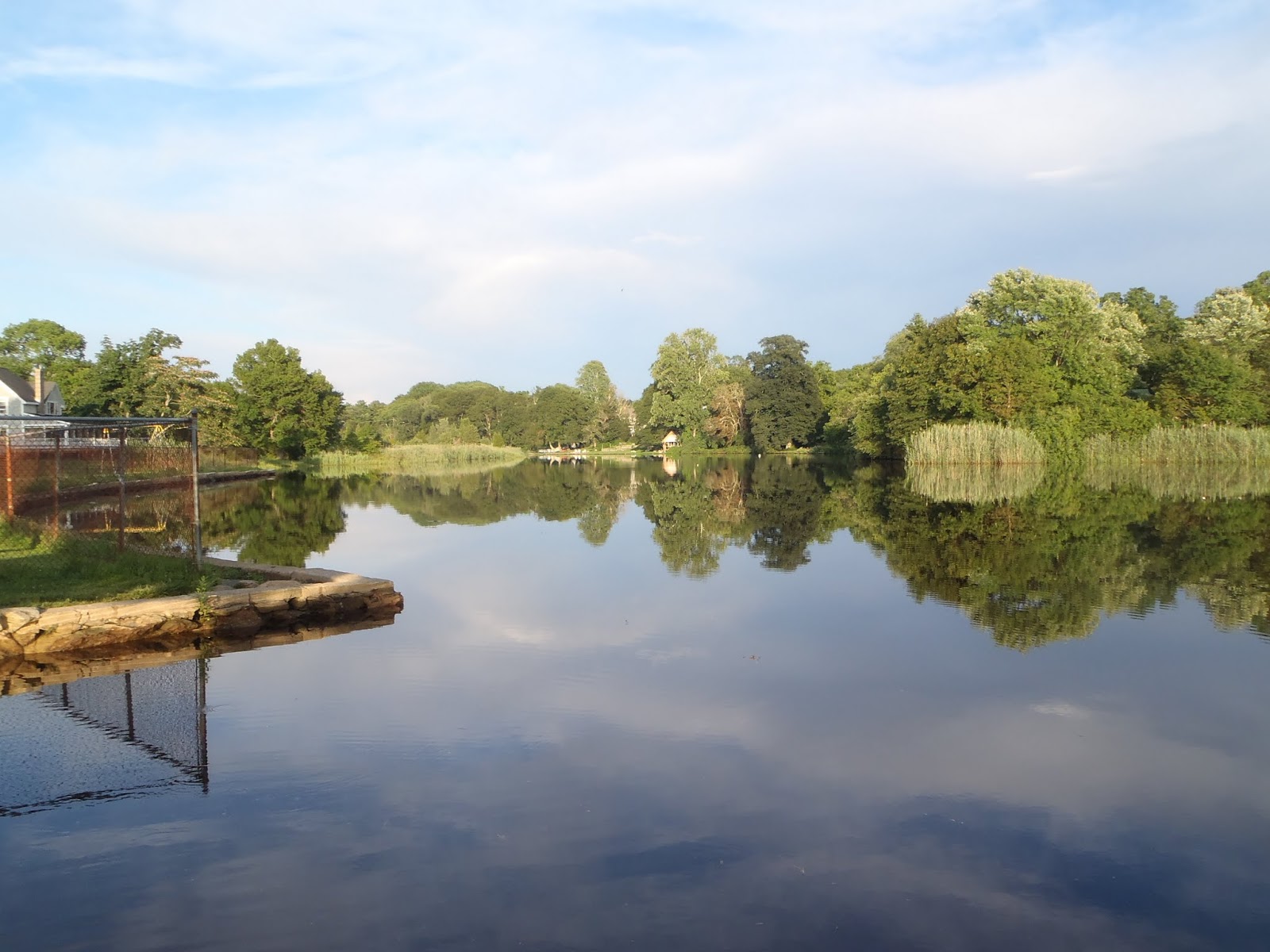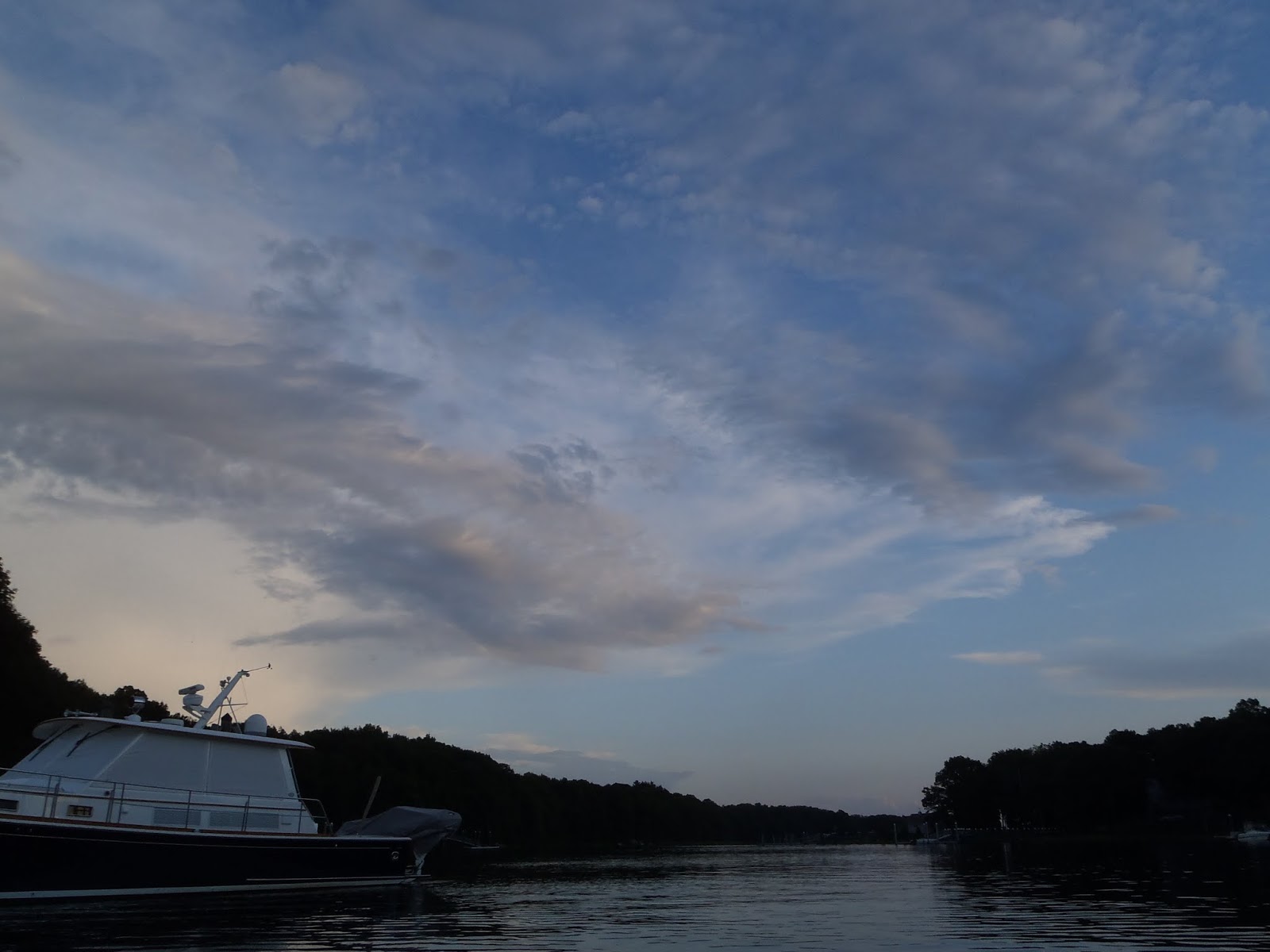The white line shows my rough track.
I've
never traveled overnight by kayak. Last
winter I planned an overnight using my two-man kayak, Serendipity--even going as far as loading gear into the drybag--but
circumstances prevented. I still wanted
to go kayak camping, and it occurred to me that, with the lighter gear
requirements of summer camping, I might be able to cram enough stuff into my
single-seater, Musketaquid. Over a few days, I fiddled with gear, making
it fit and still get the balance right.
Yesterday
the opportunity came for a little test run: the rest of the family was out of
town, I had no appointments, and tide and weather looked manageable.
I put the
kayak in the Assonet River in early evening at the top of the flood. An evening departure risked not finding a
campsite in daylight, but parts of Assonet Bay turn almost into mudflats at low
tide, and I didn't want to fight current, so I needed to wait until high slack
tide. I paddled under the highway, across
the Bay and down the short river (the gentlest breeze against my face) to its
confluence with the mighty Taunton, then up a little salt marsh creek as the
sun set; total distance three miles.
There
are few places one can camp ashore, which is one reason I almost always sleep
aboard when sailing. But Google Earth
showed this particular bit of river bank to be uninhabited, with no buildings
close by.
Entering
the creek, I annoy a pair of majestic ospreys.
In the past, I've seen ospreys only around nest platforms, but this pair seemed to have found their own
nest site.
I
worried that there might be no accessible shore to land on, but a short
distance up the creek a bank appeared right up against the high mash, allowing
me to go ashore as if on a dock.
Climbing through the bullbriar in the twilight, a nice grassy spot appeared. But I moved on when I realized the standing dead tree beside it was poised to fall. I at last found a camp
site that was open, level, and easy to clean up. By the time I had all the gear at the
campsite it was quite dark, and I put up the tent by the light of my little
headlamp. By 9pm I had my stuff
organized, mattress inflated, and had poured myself a glass of cabernet. (Whether sleeping in a boat or camping
ashore, the evening isn't complete without red wine.)
Checking
my bird book, I confirmed the identity of the ospreys, and also learned that
they are unique among raptors by diving headfirst into the water and catching
fish with their feet. Shortly after, a
great splashing sound from the creek was perhaps a fishing osprey.
My
light fleece bag turned out to be unequal to the nighttime temperatures, and I
was rather cold.
I was
up next morning at 5:10, bolt upright and filled with foreboding: I had left the kayak on
the high marsh beside the creek, and tides were getting more extreme as the
moon neared full. Would my kayak float
off? The boat was indeed almost afloat
when I got to it, but still firmly stuck in the grass. I broke camp, about as quickly as I was able,
only stopping to make coffee: this time I didn't want to fight the current going
back upriver in the middle of the ebb.
Nevertheless,
I made time to explore a bit in daylight, and to paddle the rest of the way up
the creek. Coming back down the creek, I watched the Phragmites freshwater marsh give way to a narrow band of cattails, then Spartina saltmarsh.
I was
out of the creek and on my way a little after 7am, hoping the current wouldn't
be too strong. In the narrow part of the
Assonet River the current was running at about one knot against me--a little
annoying, but not insurmountable. (I broke
from working against it to try to capture a half-dozen swallow-like birds
playing around a dock, but was too slow with my camera. They reminded me of chimney swifts, but with
more deeply-forked tails; bank swallows and tree swallows are possibilities.) Another worry was the current under the
highway, but I slipped through in the shallows without an issue, landing back
at my car before 9am.
I was
quite satisfied with the trip. I may try
to do our regular Boston Harbor Islands camp out by kayak. It was pleasant to have little enough stuff
that it wasn't a major production to pack and carry gear, and make and break
camp.
Ready to push off.
Barely a ripple on Assonet River.
Beautiful and complex sky over the river.
Tall saltmarsh cordgrass, Spartina alterniflora, is in full bloom.
Taunton River, then zoomed in on the distant Braga Bridge.
Approaching salt marsh and creek as sun sets.
All this stuff came out of a twelve-foot kayak.
This dead tree was so rotten I couldn't figure out why it was still standing.
I camped elsewhere: a dead tree fell very close to me during a blizzard not long ago.
The tapping and call of downy woodpeckers showed that dead trees were common.
The marsh at dawn. I was glad I decided not to camp on the marsh itself
when I saw how far the tide rose in the morning. A marsh bird made a whirring call.
My campsite turned out to be at the foot of
two red oaks and a red maple.
The mouth of the stream from the hilltop above camp.
A broad path shows that others have been here, but trees
fallen across the trail argue that it has seen no vehicles recently.
For me, black birch is one tree that says "wild New England."
Bullbriar, with its wicked thorns, was everywhere, complicating walking
in the dark and the search for a campsite. I lost a bit of blood this trip.
The area had not one but two kinds of blueberries:
a highbush form, and a lowbush.
This delicate little plant is a relative of Solomon's seal.
The short cordgrass of the high marsh, Spartina patens, is just flowering
--a little behind its sister species.
Looking upstream and down as boat is loaded.
Farewell to the marsh.
Head of navigation; stream so narrow it's hard to turn around.
Headed back downstream.
Headed back into the Taunton, then for home.


































No comments:
Post a Comment